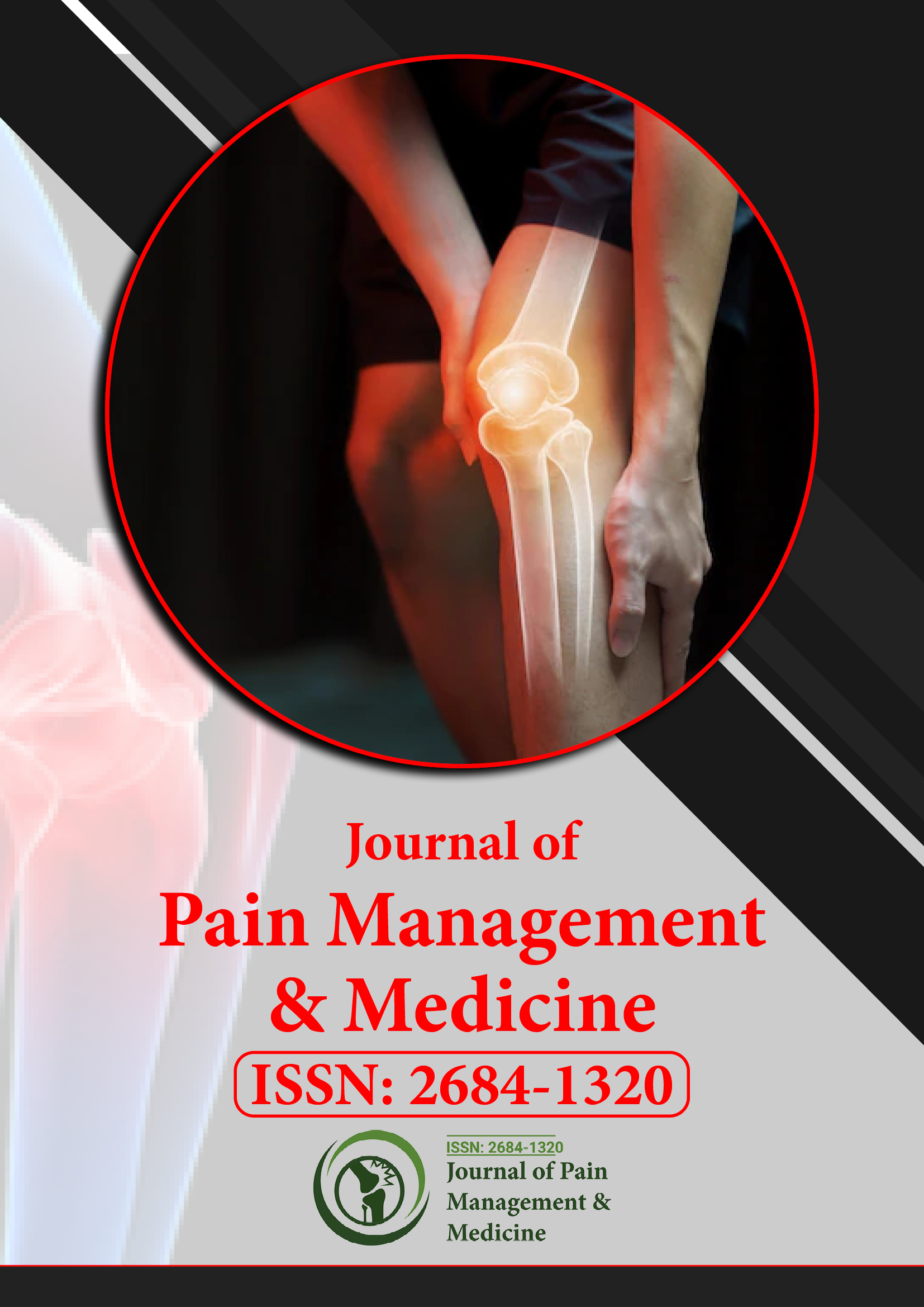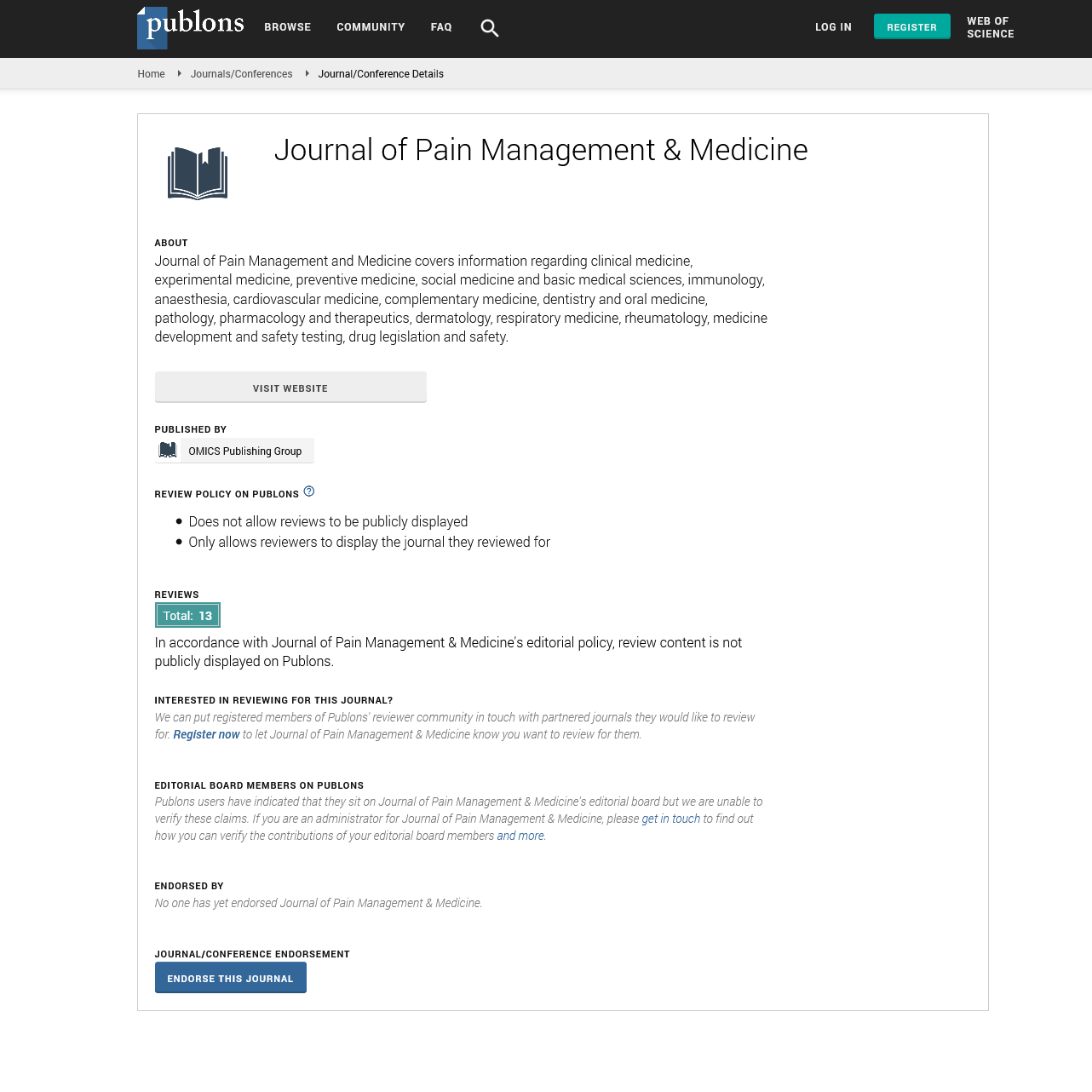Indexed In
- RefSeek
- Hamdard University
- EBSCO A-Z
- Publons
- Euro Pub
- Google Scholar
- Quality Open Access Market
Useful Links
Share This Page
Journal Flyer

Open Access Journals
- Agri and Aquaculture
- Biochemistry
- Bioinformatics & Systems Biology
- Business & Management
- Chemistry
- Clinical Sciences
- Engineering
- Food & Nutrition
- General Science
- Genetics & Molecular Biology
- Immunology & Microbiology
- Medical Sciences
- Neuroscience & Psychology
- Nursing & Health Care
- Pharmaceutical Sciences
Short Communication - (2022) Volume 8, Issue 6
An Overview of Pain Management and its Classification
Teshome Mitiku*Received: 01-Nov-2022, Manuscript No. JPMME-22-19351; Editor assigned: 03-Nov-2022, Pre QC No. JPMME-22-19351 (PQ); Reviewed: 18-Nov-2022, QC No. JPMME-22-19351; Revised: 25-Nov-2022, Manuscript No. JPMME-22-19351 (R); Published: 05-Dec-2022, DOI: 10.35248/ 2684-1320.22.8.186
Description
Pain management is a field of medicine and health care that deals with the reduction of pain (General anesthesia, pain medication, and pain control) in various dimensions, ranging from acute and simple to chronic and complicated. Most physicians and other healthcare professionals provide some pain control as part of their daily procedure, and for more complicated cases of pain, people discover additional support from pain medicine, a medical specialty focused to pain.
Types of Pain Management
There are various types and causes of pain, which can be classified into eight categories to help in pain management:
Acute pain
This occurs suddenly but only lasts for a short period. Acute pain is generally provided on a particular incident or injury, such as: A fractured bone, a car accident or the other type of accident, separates or burns, dental treatment, childbirth and labor, and surgical procedure [1,2].
Chronic pain
Chronic pain is described as pain that usually lasts more than six months and it is experienced on a daily basis. The pain has advanced as acute pain, but it has remained active long after the initial injury or event has healed or resolved. Chronic pain can vary from mild to severe and it is associated with a variety of conditions, which include: Joint pain, back pain, cancer, circulation difficulties, light-headedness, kidney failure, chronic fatigue syndrome is triggered. Chronic pain can have a negative effect on a person's quality of life, preventing humans from performing physical activities. Sometimes it can cause depression or social exclusion in some people [3,4].
Breakthrough pain
Breakthrough pain is characterized by a sudden, specific, and large increase in pain in people who are already carrying medications to alleviate chronic pain caused by conditions such as arthritis, cancer, or chronic fatigue syndrome. Break through pain is also known as a pain flare can occur with physical activity or exercise coughing, chronic condition, stress, or between pain medication dose levels. The pain is frequently severe, but the location is usually similar to the person's chronic pain.
Bone pain
Pain or discomfort, muscle aches, or pain in one or more bones that occurs during exercise and relaxation. Cancer, a fracture (broken bone), infection, leukemia, mineral deficiency, sickle cell anemia, or osteoporosis all are conditions or diseases that cause bone pain. Pregnant women frequently experience pelvic girdle pain [3].
Nerve pain
Peripheral neuropathy or inflammation causes nerve pain. It is commonly described as a sharp, death, burning, or injuring pain it is also known as neuralgia or neuropathic pain. Others characterize as an electric shock, and it is frequently worse at night.
Nerve pain can significantly damage a person's life by interfering with their sleep, function, and physical activity levels. They are frequently extremely sensitive to the cold and may experience pain with the slightest pressure. Many people who suffer from chronic nerve pain experience anxiety or depression. People who suffer from neuropathic pain are sometimes extremely sensitive to touch or heat and they will experience pain as a result of stimulation that would not usually be painful, such as brushing their skin. Common causes of nerve pain include: Alcohol addiction, Injuries to the central nervous system, peripheral nervous system, or spinal cord, Cancer, circulation difficulties, diabetes, zoster herpes (shingles), surgical removal of a limb multiple sclerosis, stroke, and disorder of vitamin B12 [5].
Phantom pain
Phantom pain refers to pain that appears to originate from a part of the body that no longer functions. It is common in people who have had a limb amputated, but it is not the same as phantom limb sensory perception, which is typically painless. Historically, investigations indicate phantom pain was a psychological condition, but now they recognize that these are real pain sensations that originate in the brain and spinal cord. It usually improves with time, but organizing phantom pain can be difficult for some people.
Soft tissue pain
This is pain or discomfort caused by muscle, tissue, or ligament damage or inflammation. It can be associated by swelling or bruising, and the following are common causes: Back or neck pain, joint inflammation, swelling and redness, chronic fatigue syndrome, chronic lower back pain, Sports-related injuries, such as sprains or strains, and Temporo-Mandibular Joint (TMJ) syndrome.
Referred pain
Referred pain that appears to be returning from one location but it is caused by an injury or inflammation in another structure or tissue. During a heart attack, for example, pain is frequently felt in the neck, left shoulder, and down the right arm. An adrenal gland injury or inflammation is frequently felt as constant pain in the upper stomach area that radiates to the back. A ruptured spleen can cause shoulder blade pain. Referred pain occurs as a result of an interconnected system of sensory nerves that supply many different tissues. An injury in one part of the system can be misinterpreted by the brain as occurring in another component of the infrastructure.
References
- McQuay H. Opioids in pain management. Lancet. 1999;353(9171):2229-2232.
- Ferrell BA. Pain management. Clin Geriatr Med. 2000;16(4):853-873.
- Morad A, Farrokh S. Essentials of anesthesia for neurotrauma. 2018;pp: 447-460.
- Gatchel RJ. Clinical essentials of pain management. American Psychological Association. 2005.
- Gerner P. Postthoracotomy pain management problems. Anesthesiol Clin. 2008;26(2):355-367.
Citation: Mitiku T (2022) An Overview of Pain Management and its Classification. J Pain Manage Med.8:186.
Copyright: © 2022 Mitiku T. This is an open access article distributed under the terms of the Creative Commons Attribution License, which permits unrestricted use, distribution, and reproduction in any medium, provided the original author and source are credited.

